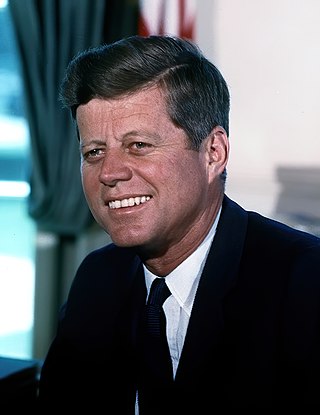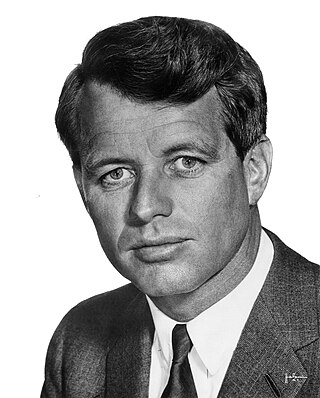| ||
|---|---|---|
35th President of the United States Tenure Appointments Presidential campaign Assassination and legacy | ||
The following is a timeline of the presidency of John F. Kennedy from January 1, 1963, to November 22, 1963, upon his assassination and death.
| ||
|---|---|---|
35th President of the United States Tenure Appointments Presidential campaign Assassination and legacy | ||
The following is a timeline of the presidency of John F. Kennedy from January 1, 1963, to November 22, 1963, upon his assassination and death.

| | This section is empty. You can help by adding to it. (July 2019) |
| | This section is empty. You can help by adding to it. (July 2019) |




On November 22, 1963, John F. Kennedy, the 35th president of the United States, was assassinated while riding in a presidential motorcade through Dealey Plaza in Dallas, Texas. Kennedy was in the vehicle with his wife, Jacqueline, Texas Governor John Connally, and Connally's wife, Nellie, when he was fatally shot from the nearby Texas School Book Depository by former U.S. Marine Lee Harvey Oswald. The motorcade rushed to Parkland Memorial Hospital, where Kennedy was pronounced dead about 30 minutes after the shooting; Connally was also wounded in the attack but recovered. Vice President Lyndon B. Johnson was hastily sworn in as president two hours and eight minutes later aboard Air Force One at Dallas Love Field.

This article outlines the timeline of events before, during, and after the assassination of John F. Kennedy, the 35th president of the United States.

Timequest is a 2000 science-fiction film directed by Robert Dyke and starring Victor Slezak as John F. Kennedy, Caprice Benedetti as Jacqueline Kennedy, and Ralph Waite as the Time Traveler. The film also features Vince Grant and Bruce Campbell. After premiering on April 13, 2000, the film had a limited theatrical release in the United States, followed shortly by distribution on VHS and DVD to the United States, Canada, and Australia. Timequest explores the science fiction theme of altering the present day by traveling back in time and tampering with past events – specifically, preventing the assassination of John F. Kennedy.

John Fitzgerald Kennedy, often referred to as JFK, was an American politician who served as the 35th president of the United States from 1961 until his assassination in 1963. He was the youngest person elected president. Kennedy served at the height of the Cold War, and the majority of his foreign policy concerned relations with the Soviet Union and Cuba. A Democrat, Kennedy represented Massachusetts in both houses of the United States Congress prior to his presidency.
The John F. Kennedy assassination and the subsequent conspiracy theories surrounding it have been discussed, referenced, or recreated in popular culture numerous times.

John F. Kennedy's tenure as the 35th president of the United States began with his inauguration on January 20, 1961, and ended with his assassination on November 22, 1963. Kennedy, a Democrat from Massachusetts, took office following his narrow victory over Republican incumbent vice president Richard Nixon in the 1960 presidential election. He was succeeded by Vice President Lyndon B. Johnson.

Robert Francis Kennedy, also known by his initials RFK, was an American politician and lawyer. He served as the 64th United States attorney general from January 1961 to September 1964, and as a U.S. senator from New York from January 1965 until his assassination in June 1968, when he was running for the Democratic presidential nomination. Like his brothers John F. Kennedy and Ted Kennedy, he was a prominent member of the Democratic Party and is an icon of modern American liberalism.

The CIA Kennedy assassination is a prominent conspiracy theory regarding the assassination of John F. Kennedy, and is the most popular theory outside of the lone gunman narrative. According to ABC News, the Central Intelligence Agency (CIA) is represented in nearly every theory that involves American conspirators. The secretive nature of the CIA, and the conjecture surrounding the high-profile political assassinations in the United States during the 1960s, has made the CIA a plausible suspect for some who believe in a conspiracy. Conspiracy theorists have ascribed various motives for CIA involvement in the assassination of President Kennedy, including Kennedy's firing of CIA director Allen Dulles, Kennedy's refusal to provide air support to the Bay of Pigs invasion, Kennedy's plan to cut the agency's budget by 20 percent, and the belief that the president was weak on communism.
John M. Newman is an American author and retired major in the United States Army. Newman was on the faculty at the University of Maryland from 1995 to 2012, and has been a Political Science professor at James Madison University in Harrisonburg, Virginia since January 2013.

The American University speech, titled "A Strategy of Peace", was a commencement address delivered by United States President John F. Kennedy at the American University in Washington, D.C., on Monday, June 10, 1963. Widely considered one of the most powerful speeches Kennedy delivered, he not only outlined a plan to curb nuclear arms, but also "laid out a hopeful, yet realistic route for world peace at a time when the U.S. and Soviet Union faced the potential for an escalating nuclear arms race." In the speech, Kennedy announced his agreement to negotiations "toward early agreement on a comprehensive test ban treaty" and also announced, for the purpose of showing "good faith and solemn convictions", his decision to unilaterally suspend all U.S. atmospheric testing of nuclear weapons as long as all other nations would do the same. Noteworthy are his comments that the United States was seeking a goal of "complete disarmament" of nuclear weapons and his vow that America "will never start a war".
The United States foreign policy during the presidency of John F. Kennedy from 1961 to 1963 included diplomatic and military initiatives in Western Europe, Southeast Asia, and Latin America, all conducted amid considerable Cold War tensions with the Soviet Union and its satellite states in Eastern Europe. Kennedy deployed a new generation of foreign policy experts, dubbed "the best and the brightest". In his inaugural address Kennedy encapsulated his Cold War stance: "Let us never negotiate out of fear. But let us never fear to negotiate".

The assassination of President John F. Kennedy on November 22, 1963 has spawned numerous conspiracy theories. These theories allege the involvement of the CIA, the Mafia, Vice President Lyndon B. Johnson, Cuban Prime Minister Fidel Castro, the KGB, or some combination of these individuals and entities. Some conspiracy theories have alleged a coverup by parts of the federal government, such as the original FBI investigators, the Warren Commission, or the CIA. Former Los Angeles District Attorney Vincent Bugliosi estimated that a total of 42 groups, 82 assassins, and 214 people had been accused at one time or another in various conspiracy scenarios.

JFK and the Unspeakable: Why He Died and Why It Matters is a book by theologian and Catholic Worker James W. Douglass that analyzes the presidency of John F. Kennedy as well as the events surrounding his assassination. The book is drawn from many sources, including the Warren Report. The book's central thesis is that Kennedy was a cold warrior who turned to peace-making, and that as a result he was killed by his own security apparatus.
National Security Action Memorandum Number 263 (NSAM-263) was a national security directive approved on 11 October 1963 by United States President John F. Kennedy. The NSAM approved recommendations by Secretary of Defense Robert McNamara and Chairman of the Joint Chiefs of Staff General Maxwell Taylor. McNamara and Taylor's recommendations included an appraisal that "great progress" was being made in the Vietnam War against Viet Cong insurgents, that 1,000 military personnel could be withdrawn from South Vietnam by the end of 1963, and that a "major part of the U.S. military task can be completed by the end of 1965." The U.S. at this time had more than 16,000 military personnel in South Vietnam.

National Security Action Memorandum 273 (NSAM-273) was approved by new United States President Lyndon Johnson on November 26, 1963, one day after former President John F. Kennedy's funeral. NSAM-273 resulted from the need to reassess U.S. policy toward the Vietnam War following the overthrow and assassination of President Ngo Dinh Diem. The first draft of NSAM-273, completed before Kennedy's death, was approved with minor changes by President Johnson.
The presidency of Lyndon B. Johnson began on November 22, 1963, when Lyndon B. Johnson became the 36th president of the United States following the assassination of President John F. Kennedy. His term ended on January 20, 1969.
This bibliography of John F. Kennedy is a list of published works about John F. Kennedy, the 35th president of the United States.
The following is a timeline of the presidency of John F. Kennedy from his inauguration as the 35th president of the United States on January 20, 1961, to December 31, 1961.
The following is a timeline of the presidency of John F. Kennedy from January 1, 1962, to December 31, 1962.
The following is a timeline of the presidency of Gerald Ford from January 1, 1975, to December 31, 1975.
I have reviewed your letter of January 21 regarding the application for clemency in behalf of Mr. Feguer. Taking all factors into account, it is my decision that the petition should be and is hereby denied.